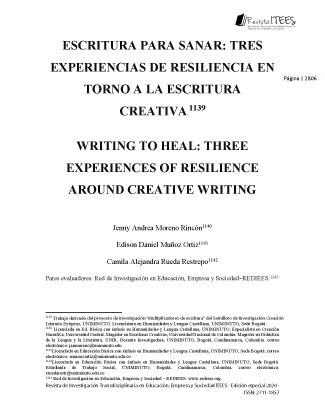CXLVI. WRITING TO HEAL: THREE EXPERIENCES OF RESILIENCE AROUND CREATIVE WRITING
##plugins.themes.bootstrap3.article.main##
Abstract
Creative writing has gained strength during the last decade in Colombia as one of the artistic
manifestations in which the emerging creators have been called to participate. However, from
the classrooms and specially, from the bachelor’s degree major in Humanities and the
Spanish Language, it has begun to emerge as a fundamental element in the transformation of
communities, especially on those that are vulnerable.
Considering what was previously said, the students' research group named Creation Exegesis
UNIMINUTO, that belongs to the bachelor’s degree major in Humanities and Spanish
language at Minuto de Dios University, the macro project "Writing multipliers" has been
created. It pretends to demonstrate how writing is an important skill that reflects some
difficult processes that different vulnerable communities have gone through to develop
creativity and re-invention of different world. Thus, based on writing we can work on aspects
such as grief, resilience, and resignification.
This presentation aims to show three projects developed from creative writing. The first one
is focused on writing for resilience with boys’ and girls’ victims of commercial sexual
exploitation (CSEC). The second one works on writing for grieving with companions of
people who have died from cancer. The third one focuses on writing of resignification
through autobiography with elderly street dwellers.
Download Statistics
##plugins.themes.bootstrap3.article.details##
creative writing, elderly, CSEC, grief, resilience
cuento terapéutico. [Ebook] Psicodebate 8. Psicología, Cultura y Sociedad.
Recuperado en:
https://dspace.palermo.edu/ojs/index.php/psicodebate/article/view/413/193
Cárdenas, M; & Salinas, P. (2009). Métodos de investigación social. Recuperado de
https://biblio.flacsoandes.edu.ec/catalog/resGet.php?resId=55376
Cobo, M. (2003). Quien soy “yo” Reflexiones acerca de la identidad personal. Madrid:
Acento Editorial.
Demetrio, D. (1999). La autobiografía como curación de uno mismo. Barcelona: Paidós
Ibérica.
Departamento Administrativo Nacional Estadístico. (2018). Documento de caracterización
sociodemográfica proyectos especiales (CHC), Censo habitantes de calle.
Recuperado de https://www.dane.gov.co/files/investigaciones/boletines/censohabitantes-calle/caracterizacion-hab-calle-bogota-2017.pdf
González, A. (2017). El diario: la escritura autobiográfica en su dimensión sociocultural y
sus posibilidades cognoscitivas y creativas. La palabra, (30), 151-167. Recuperado de
http://www.scielo.org.co/pdf/laplb/n30/0121-8530-laplb-30-00151.pdf
Goss, S. (2013). Therapeutic Writing. Therapeutic Innovations in Light of Technology,
[online] (4), pp.10-20. Recuperado en:
http://onlinetherapyinstitute.com/mag/tiltissue15.pdf
Jaramillo, Restrepo y Restrepo (2011), Escritura emocional: una estrategia para la
resocialización del habitante de la calle adulto de Medellín, ¿recuperado de
http://ridum.umanizales.edu.co:8080/xmlui/bitstream/handle/6789/1827/Restrepo_S
a ndra_Milena_2014.pdf?sequence=1&isAllowed=y
Malaver, C. (2017), Relatos de la explotación sexual, el delito que se roba la infancia,
recuperado de http://www.eltiempo.com/bogota/historias-de-explotacionsexualinfantil-en-bogota-67370)
Porta, L. (2010). La investigación biográfico-narrativa en educación: entrevista a Antonio
Bolívar. 1st ed. [ebook] Revista de Educación, pp.201-212. Recuperado en:
https://www.academia.edu/32443884/La_investigaci%C3%B3n_biogr%C3%A1fico
_narrativa_en_educaci%C3%B3n_entrevista_a_Antonio_Bol%C3%ADvar
Ricoeur, P. (1999). La lectura del tiempo pasado: memoria y olvido. España: Arrecife
Producciones, S. L.
Rodríguez, M. (2011). Manual de escritura curativa. España: Almuzara.
Sacks, O. (1985). The man who mistook his wife for a hat. Londres: Gerald Duckworth &
Co.





